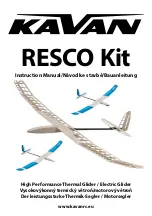
SPIRAL DIVE
DEEP STALL
DEFLATIONS
Your glider is designed to exit immediately from any deep-stall configuration
within four seconds of the brakes or B-line stall being released. If you find yourself
in a deep-stall situation (loss of forward speed, low internal wing pressure) ensure
your brakes are up. If your glider does not return to normal flight, you should
gently push the A-risers forward until the glider surges slightly and normal flight
is resumed.
When you turn a series of tightening 360s the paraglider will enter a spiral - a
highly banked turn with rapid height loss. The longer you hold the inside brake
on, the faster the turn becomes. Safe descent rates of 8metres/second (500
ft/min approx.) are possible in a spiral dive, but at these high speeds and G-forces
it is easy to become disorientated, so you must pay particular attention to altitude.
To exit the spiral dive, slowly release the inside brake and apply a small amount
of outside brake. As the glider begins to decelerate it is important to allow it to
continue in its turn until enough energy has been lost for it to return to level flight
without excessive surging.
Spiral dives with sink rates over 8 m/s are possible, but should be avoided. They
are dangerous and put unnecessary strain on the glider.
IMPORTANT: SPIRAL DIVES CAUSE DISORIENTATION AND NEED TIME
AND HEIGHT TO RECOVER. DO NOT PERFORM THIS MANOEUVRE NEAR
THE GROUND.
Due to the flexible form of a paraglider, turbulence may cause a portion of the
wing suddenly to collapse.
An asymmetrical collapse can be easily controlled by weight shifting to the open
side and applying the minimum amount of brake required to control your
direction. A long, smooth progressive pump on the deflated side will assist
reinflation. (Flapping your arms uncontrollably will not help).
A symmetrical collapse should reinflate quickly without pilot input, however 15 to
20cm of brake applied symmetrically will speed the process.
Active flying will virtually eliminate any tendency to collapse.
9
Summary of Contents for OCTANE
Page 1: ...OCTANE PILOT S MANUAL ...
Page 2: ......
Page 4: ......
Page 6: ......
Page 25: ...DHV CERTIFICATE OCTANE M 19 ...
Page 26: ...DHV CERTIFICATE OCTANE L 20 ...
Page 27: ...DHV CERTIFICATE OCTANE XL 21 ...
















































